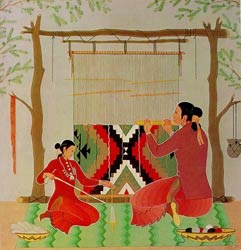
Like all art forms, Navajo rugs have changed in design, construction and use over the years, but one fact remains consistent – the rugs are inherent illustrations of the Navajo culture.
Years and years ago, weavers probably sat at crude looms to weave the hair of game animals, horses or humans; plant fibers, bark fibers and feathers. Out of necessity, these early looms, probably with a single support, evolved into a more framelike loom with a pair of closely placed stakes connected by a third across the top of both.
This provided a place for warp thread that could then be plaited or twined into mats and other expanses of fabric. Looms of this type are still in use among Navajo weavers today.
Initially, the natural fibers used allowed for color schemes that included ivory, brown, gray, tan and black. With the introduction of vegetable dyes, still before the presence of white cultures, rust, yellow and green were available as well.
It was the Spanish who brought indigo dye to the Navajo, and later also brought a cloth called “baize,” which the Navajo weavers unraveled and spun again into their sheep’s wool to create a shade of red.
Navajo weaving is generally classed by six “periods:”
- The Early Classic Period / 1700 – 1850: The Spanish were making inroads into Navajo territories. It is believed the Navajo learned to weave from Pueblo cultures who escaped to Navajo lands while fleeing the invasion of the Spanish during the 1600s. While the presence of the Spanish was not welcome, they did introduce sheep to native populations, and with the sheep, wool, which ultimately replaced early weaving materials.
- The Classic Period / 1850 – 1863: The creations of Navajo weavers became increasingly in demand in trades by members of other tribes and while military personnel. Weaving was permanently embedded in the Navajo culture by this time as well, and even when the government imprisoned and moved them to New Mexico in 1863, away from their sheep and wool, they continued to weave by returning to the use of fiber.
- The Transition Period / 1868 – 1890: The release of the Navajo and the return to their homelands only enhanced the production of weavings. The introduction of commercial yarns also brought new colors to the rugs and blankets at this time.
- The Rug Period / 1890 – 1920: During this period, the Navajo blanket makers began to get competition from commercial rug producers like Pendleton, so they turned their attention to denser weavings that could be used as rugs. During this time “style” also began to evolve. Juan Hubbell of the famed Hubbell Trading Post family in Ganado, Arizona had a strong influence on Navajo weavers. He encouraged them to strive for quality over quantity and to preserve the classic designs of the old days. One design of crosses, stripes and diamonds set in deep red and bordered in black became known as the “Ganado” style. John B. Moore of Crystal, New Mexico also played a key role in the stylization and popularity of Navajo rugs. He would send native wools to the East for cleaning and dying and shared his design ideas with Navajo. Moore’s concepts evolved into the “Two Gray Hills” and “Crystal” styles, and he was the first to begin a successful mail order rug business.
- The Revival Period / 1920 – 1940: The boom of the early Rug Period had ended with a true bust. The U.S. government had introduced French Rambouillet sheep to the reservation. While these sheep produced large amounts of wool and mutton for food, the quality of the wool was inferior. Despite the best efforts of the Navajo weavers the quality of the rugs went down and so did sales. The Revival Period brought life back to the craft. Leon McSparron of the Chinle Trading Post and Mary C. Wheelwright, a patron of the Navajo people, lobbied for a return to the use of vegetable dyes. But commercial dyes were not completely abandoned, as dye companies actually developed special toned and easy-to-use products specifically for Navajo weavers. During this period the Navajo Sheep Breeding Laboratory, to explore and generate the finest wools; and the Navajo Arts and Crafts Guild, which provided quality and authenticity control; were formed.
- Regional Style Period / 1940 – present : With the success of styles like Ganado and Two Gray Hills, more rugs were created on the premise of reservation locale – Ganado, Shiprock, Lukachukai, Teec Nos Pos, Crystal, Two Gray Hills, Chinle, Wide Ruin and Tonalea.





